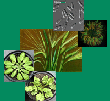| Fetene, M; Beck, E: Water relations of indigenous versus exotic tree species, growing at the same site in a tropical montane forest in southern Ethiopia, Trees, 18, 428-435 (2004), doi:0.1007/s00468-004-0321-3 | |
| Abstract: The objective of the study was to compare the water relations of two indigenous [Podocarpus falcatus (Thunb.) Endl., Croton macrostachys Hochst. ex. Del.] and two exotic tree species (Eucalyptus globulus Labille., Cupressus lusitanica Miller) growing in the same location in the montane Munessa State Forest, southern Ethiopia. Stem flow was measured with Granier type thermal dissipation probes. Sap flux, normalized per unit sapwood area, and the total sapwood areas of the particular trees were used to estimate daily transpiration. Maximum daily transpiration values (60 kg water) were recorded for Croton when at full foliage. After shedding most of its leaves in the dry season transpiration was reduced to 8 kg per day. Eucalyptus had the next highest transpiration (55 kg), in this case at the peak of the dry season. It transpired 4–5 times more than Podocarpus and Cupressus trees of similar size. Maximum stem flux density was tree-size dependent only in Croton. Diurnal patterns of stem flux indicated that Croton, Eucalyptus and Podocarpus, in contrast to Cupressus, responded more directly to light than to atmospheric water pressure deficit. At high VPD (>1.0 kPa) stem flux reached a plateau in Croton and Podocarpus indicating stomatal limitation. Per unit leaf area Croton had the highest and Podocarpus and Cupressus the lowest daily transpiration rates. In summary, the pioneer tree Croton had the lowest and Podocarpus the highest water use efficiency. The contribution of the study to the understanding of the role of each tree species in the hydrology of the natural forest and the plantations is discussed. |

